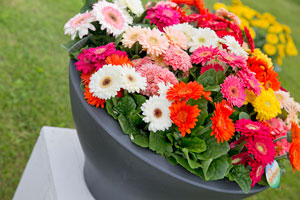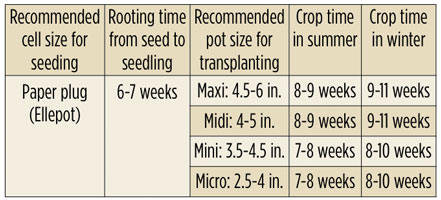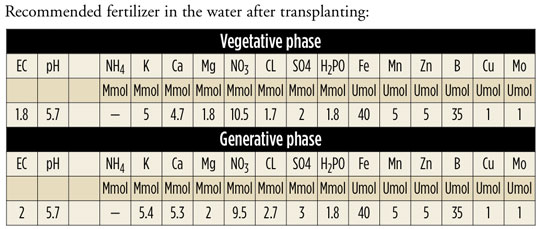5/29/2014
Sundayz Gerbera: Indoor Performance for Outdoor Use
Arthur Kramer

Sundayz Outdoor Gerberas are compact plants with excellent outdoor performance, especially developed for the use on terraces and balconies. Sundayz carry double flower heads, which have less pollination and will last longer than your average gerbera pot plant. It’s a highly flexible series, available in Maxi, Midi, Mini and Micro flower size for 2.5- to 6-in. pot production.
The Maxi, Midi and Micro-sized Sundayz are available as well-balanced mixes. Mini Sundayz are available in seven individual colors (White, Yellow, Orange, Red, Pink, Lilac and Bicolor), which can be mixed perfectly, too.
Scheduling
Sundayz are available year round and can be delivered as seeds and seedlings. The series has a high germination level, as well as great uniformity. Sundayz are quick flowering and easy to schedule:

Substrate and fertilizer
Germination phase from seed to seedling
For sowing in plugs, we recommend using an airy, well-draining, moist and sterile substrate mix. These are ideal values to ease the intake of microelements:
- pH—5.5 to 5.8 (at a higher pH the crop can start to grow chlorotic)
- EC—0.7 to 1.0
- 20% perlite can be added to the sowing soil
Transplanting phase from seedling to flowering plant
For transplanting the seedlings into pots, we recommend using a sterile and well-draining substrate. We advise fertilization with:
- pH—5.5 to 5.8
- EC—1.2 to 1.5
- Target value in the pots—EC: 1.0 to 1.2; pH: 5.5
- 20% perlite can be added to the transplanting soil

Irrigation
Keep the soil moist after sowing. When the seedlings start to develop, keep the plugs slightly moist as well. After transplanting, start irrigation from above for strong root development in the pots. It’s important that the crop is dry when the night falls. During the flowering phase, we advise using an ebb-and-flow system or a drip system.
Climate
Germination phase from seed to seedling
After sowing, we advise covering the plug trays with a white plastic tunnel for approximately three weeks. We recommend the following values inside the tunnel:
- Relative Humidity: 99%
- Light: 250 Watt/m2 (approximately 1,400 f.c./15,000 Lux)
- Temperature: Between 72 to 77F (22 to 25C)
- Avoid direct sunlight by screening or by the application of chalk
After 5 to 7 days, the seedlings are visible and hardening should be started. Increase ventilation of the tunnels during the following 2 to 3 weeks daily at a temp of 68 to 72F (20 to 22C). Create a humidity level (RH) of 70% to 80% in the tunnel. Fertilize the plants with water with an EC value of a maximum of 1.5 and a pH of 5.6.
Transplanting phase from seedling to flowering plant
Climate in the greenhouse:
- Light: 450 w/m2 (approximately 3,700 f.c./40,000 Lux)
- During wintertime, artificial lighting is recommended to improve the product quality. Add approximately 510 f.c. (5,500 Lux) to ensure the advised level of lighting.
- Temperature: Week 1—approximately 64F (17C) day and night; Week 2 to 4—59 to 64F (15 to 17C) day; Week 5 to 9—50 to 57F (10 to 13C) day
- After spacing (approximately 3 weeks after transplanting): The night temperature may go down to between 54 and 61F (12 and 16C).
Flowering phase
To harden the crops and to prepare them for outdoor conditions, temperatures at this stage may go down.
- Temperature: 53 to 57F (11 to 13C) at daytime and 50F (10C) at night
- Light: Start screening at a light intensity of 450/500 W/m2 (approximately 3,700 to 4,200 f.c./40,000 to 45,000 Lux)
- Relative Humidity: Keep RH under 80%
Plant growth regulators
Sundayz is a compact crop, with perfectly balanced proportions of flowers and crops, so there’s no need to use any PGRs.
Pests and diseases
The most common pests are leaf miner, whitefly, thrips, cyclamen mites, broad mites and aphids. Common diseases are botrytis, powdery mildew and pythium. When the crop is flowering, only spray as low as leaf level to avoid damaged flowers.
GT
Arthur Kramer is Area Export Manager for Florist Holland B.V. in the Netherlands.